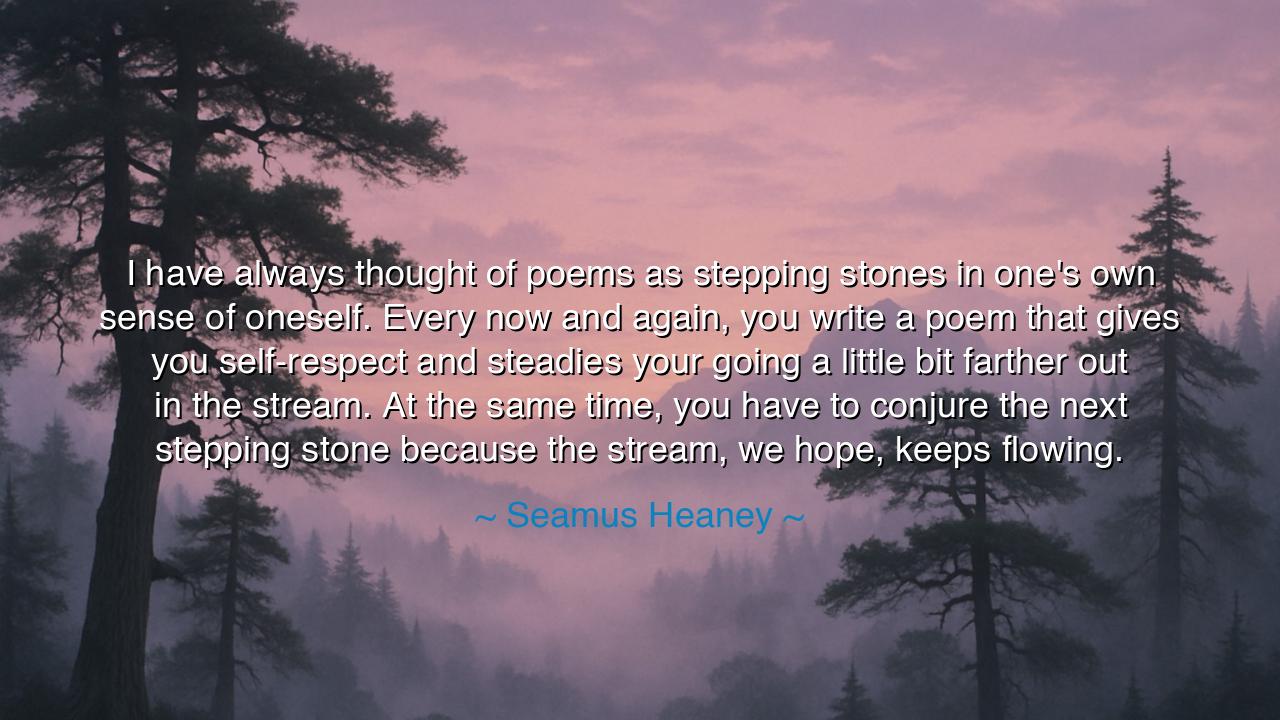
I have always thought of poems as stepping stones in one's own
I have always thought of poems as stepping stones in one's own sense of oneself. Every now and again, you write a poem that gives you self-respect and steadies your going a little bit farther out in the stream. At the same time, you have to conjure the next stepping stone because the stream, we hope, keeps flowing.






“I have always thought of poems as stepping stones in one’s own sense of oneself. Every now and again, you write a poem that gives you self-respect and steadies your going a little bit farther out in the stream. At the same time, you have to conjure the next stepping stone because the stream, we hope, keeps flowing.” — so spoke Seamus Heaney, the poet who dug with his pen as his father once dug with a spade. These words are not merely about writing verse; they are about the sacred rhythm of growth, the ceaseless journey of the human soul across the waters of time and becoming.
In the vision Heaney offers, the stream is life itself — ever-moving, ungraspable, sometimes calm, sometimes fierce. It is the current of experience that bears us forward whether we wish it or not. Upon this stream, the poet imagines the stepping stones: the moments of creation, insight, or courage that allow a soul to cross from ignorance toward understanding, from confusion toward clarity. Each poem, each act of meaning wrestled from the flow, becomes a place to stand for a while — a brief but solid truth, before one must move again into uncertainty.
Heaney’s poem is not merely words on a page. It is a symbol of every act by which a person defines themselves against the flood — every craft built from inner truth. For the farmer, it may be a harvest well gathered; for the mother, a child well taught in kindness; for the dreamer, a vision carried through fear. Each of these is a stone shaped by effort and faith, a foothold wrested from chaos. Yet, as Heaney warns, no one stone will bear us forever. The stream keeps flowing, and the pilgrim must keep stepping. To cling too long to what was once solid is to sink.
Consider the story of Siddhartha, the seeker who sat beside another river and saw in its current the whole of existence. Each moment, he realized, is born and dies in the water; nothing stays, yet all things continue. Like Heaney’s stepping stones, Siddhartha’s insights carried him farther, each revelation leading to another, until at last he ceased to fear the flow. For to live rightly is not to resist the stream, but to walk upon it — to trust the stones that rise beneath one’s feet when the time has come.
The self-respect Heaney speaks of is the quiet triumph of creation — the sense that one has brought forth something true, however small. It is not pride, but balance: the inner steadiness that allows the traveler to take the next step. When we create, when we act with integrity, we forge from within ourselves something as real as stone. It is by these moments that we remember who we are and why we move forward at all. Yet, even as we rest upon one stone, we must already be imagining the next — for the stream keeps flowing, and to live is to continue becoming.
How many souls, fearing the current, remain stranded upon old stones — holding fast to yesterday’s victories, yesterday’s truths, yesterday’s selves? They forget that what once steadied them will one day erode beneath their feet. The wise understand that no creation, no poem, no moment of grace is final. The world is movement, and the heart must move with it. Like the poet who finishes a verse only to feel the stirring of another, we too must forever conjure what comes next — not out of ambition, but out of reverence for the living stream.
Let us then learn from Heaney’s quiet power. Each of us walks across our own current, and each word we speak, each act we complete with sincerity, becomes a stepping stone of our soul. Do not despair when the water rushes or when the next stone is unseen. Trust that it will rise when your foot needs it, for that is the law of all creation: the next truth appears only when the traveler dares to step.
So take this teaching and carry it as your compass: build your stepping stones through honest work, through creation born of heart and struggle. When you finish one, bow to it with gratitude — but do not stay. Look ahead. The stream keeps flowing, and so must you. For life is not a path of stillness, but a bridge made of living words, and only those who keep walking across their own becoming will ever reach the far shore of understanding.






AAdministratorAdministrator
Welcome, honored guests. Please leave a comment, we will respond soon